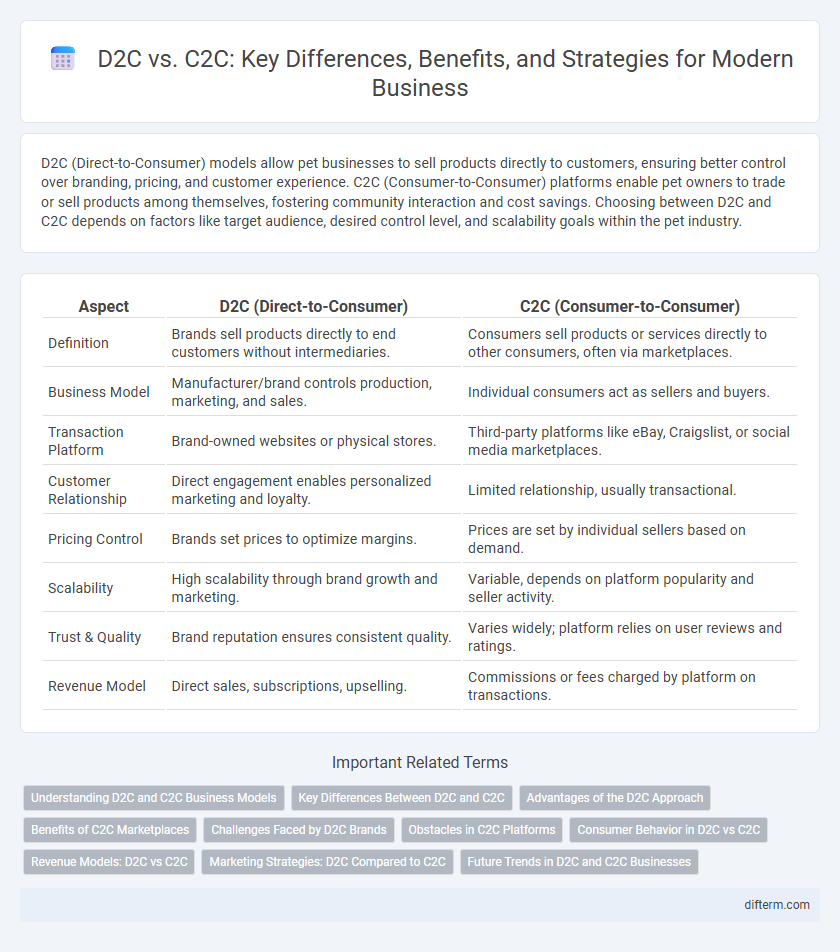D2C (Direct-to-Consumer) models allow pet businesses to sell products directly to customers, ensuring better control over branding, pricing, and customer experience. C2C (Consumer-to-Consumer) platforms enable pet owners to trade or sell products among themselves, fostering community interaction and cost savings. Choosing between D2C and C2C depends on factors like target audience, desired control level, and scalability goals within the pet industry.
Table of Comparison
| Aspect | D2C (Direct-to-Consumer) | C2C (Consumer-to-Consumer) |
|---|---|---|
| Definition | Brands sell products directly to end customers without intermediaries. | Consumers sell products or services directly to other consumers, often via marketplaces. |
| Business Model | Manufacturer/brand controls production, marketing, and sales. | Individual consumers act as sellers and buyers. |
| Transaction Platform | Brand-owned websites or physical stores. | Third-party platforms like eBay, Craigslist, or social media marketplaces. |
| Customer Relationship | Direct engagement enables personalized marketing and loyalty. | Limited relationship, usually transactional. |
| Pricing Control | Brands set prices to optimize margins. | Prices are set by individual sellers based on demand. |
| Scalability | High scalability through brand growth and marketing. | Variable, depends on platform popularity and seller activity. |
| Trust & Quality | Brand reputation ensures consistent quality. | Varies widely; platform relies on user reviews and ratings. |
| Revenue Model | Direct sales, subscriptions, upselling. | Commissions or fees charged by platform on transactions. |
Understanding D2C and C2C Business Models
D2C (Direct-to-Consumer) business models enable brands to sell products directly to customers, bypassing intermediaries, which increases profit margins and enhances brand control. C2C (Consumer-to-Consumer) platforms facilitate transactions between individual consumers, leveraging peer-to-peer networks for efficient marketplace exchanges. Understanding the distinctions reveals that D2C prioritizes brand ownership and customer data, while C2C emphasizes user-generated markets and community trust.
Key Differences Between D2C and C2C
D2C (Direct-to-Consumer) involves brands selling products directly to end customers, eliminating intermediaries to control brand experience and pricing. In contrast, C2C (Consumer-to-Consumer) platforms enable individuals to trade goods or services directly with each other, often facilitated by online marketplaces like eBay or Etsy. D2C emphasizes brand ownership and customer relationship management, while C2C centers on peer-to-peer interaction and decentralized transactions.
Advantages of the D2C Approach
The D2C approach enables brands to maintain full control over their customer experience, from product development to delivery, ensuring higher quality and consistency. Direct interaction with customers provides valuable data insights, enhancing personalized marketing and product innovation. This model reduces dependency on intermediaries, increasing profit margins and accelerating feedback loops for faster market adaptation.
Benefits of C2C Marketplaces
C2C marketplaces enable peer-to-peer transactions, reducing intermediary costs and increasing affordability for consumers. These platforms promote trust and community engagement through user reviews and direct communication, enhancing the overall buyer and seller experience. Greater market accessibility empowers small sellers and entrepreneurs, fostering diverse product offerings and niche markets within the C2C ecosystem.
Challenges Faced by D2C Brands
D2C brands encounter significant challenges including high customer acquisition costs driven by intense competition and rising digital advertising expenses. Managing supply chain logistics and inventory without traditional retail intermediaries requires robust operational capabilities. Maintaining consistent customer engagement and delivering personalized experiences while scaling often strains limited marketing resources and technology infrastructure.
Obstacles in C2C Platforms
C2C platforms face significant obstacles such as trust and security concerns, which can deter users from engaging in transactions due to the lack of formal verification and buyer protection. Payment fraud and dispute resolution pose additional challenges, often requiring robust mediation systems that many C2C platforms struggle to implement efficiently. Furthermore, inconsistent product quality and shipment delays can harm user experience and limit platform growth compared to more controlled D2C environments.
Consumer Behavior in D2C vs C2C
Consumer behavior in Direct-to-Consumer (D2C) models often emphasizes brand loyalty and personalized experiences, as buyers engage directly with manufacturers or brands. In contrast, Consumer-to-Consumer (C2C) platforms stimulate peer trust and price sensitivity, with buyers valuing peer reviews and secondhand market dynamics. Data shows D2C consumers prefer curated brand narratives, while C2C users prioritize community interaction and transaction transparency.
Revenue Models: D2C vs C2C
Direct-to-Consumer (D2C) revenue models primarily generate income through the sale of products or services directly from brands to customers, eliminating intermediaries and increasing profit margins. Consumer-to-Consumer (C2C) platforms, on the other hand, typically earn revenue via transaction fees, listing charges, or premium services facilitating peer-to-peer sales. The scalability and control over pricing in D2C contrast with C2C's dependency on user activity and platform commission structures.
Marketing Strategies: D2C Compared to C2C
D2C marketing strategies emphasize brand control, personalized customer experiences, and data-driven campaigns leveraging owned channels like websites and social media to build direct relationships and loyalty. C2C marketing relies heavily on user-generated content, peer reviews, and community trust, often utilizing platforms like online marketplaces and social networks to facilitate person-to-person sales. The D2C model prioritizes targeted advertising and customer lifecycle management, while C2C strategies focus on fostering engagement and authenticity through organic interactions.
Future Trends in D2C and C2C Businesses
Future trends in D2C (Direct-to-Consumer) businesses include increased personalization through AI-driven analytics, seamless omnichannel experiences, and sustainability-focused product lines. C2C (Consumer-to-Consumer) platforms are evolving with peer-to-peer marketplaces leveraging blockchain for secure transactions and enhanced trust. Both models are expected to integrate advanced technologies like augmented reality and social commerce to drive customer engagement and retention.
D2C vs C2C Infographic

 difterm.com
difterm.com